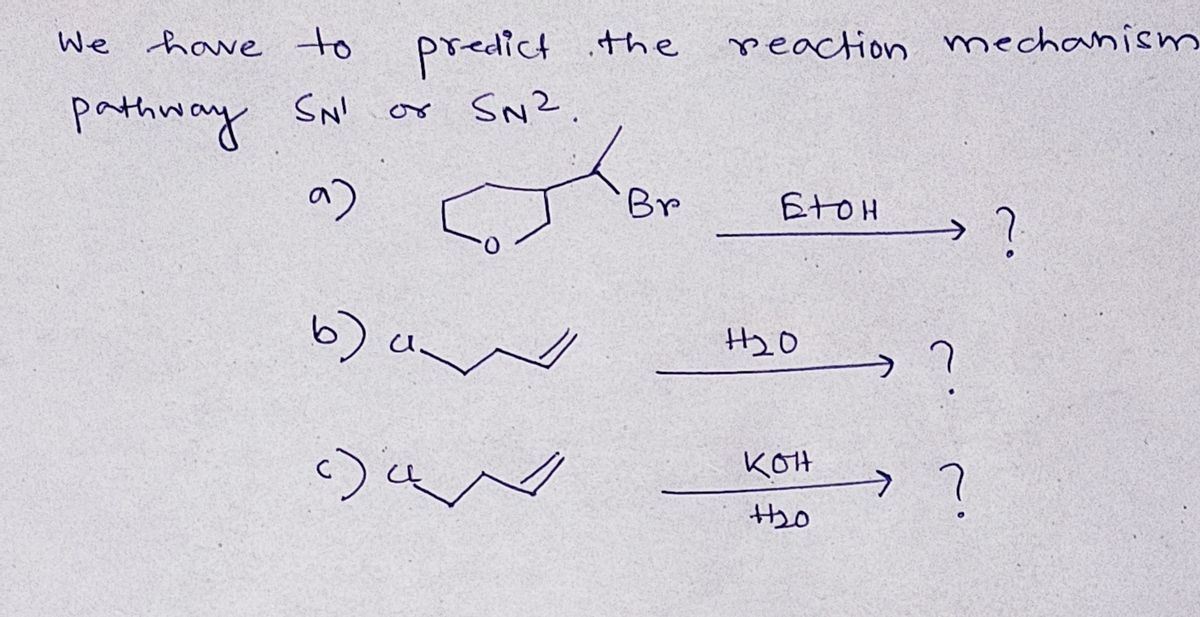Chemistry
10th Edition
ISBN:9781305957404
Author:Steven S. Zumdahl, Susan A. Zumdahl, Donald J. DeCoste
Publisher:Steven S. Zumdahl, Susan A. Zumdahl, Donald J. DeCoste
Chapter1: Chemical Foundations
Section: Chapter Questions
Problem 1RQ: Define and explain the differences between the following terms. a. law and theory b. theory and...
Related questions
Question
Complete the following reactions: indicate the mechanism (SN1 or SN2). If the reaction does not proceed, indicate so and the reason as to why it would not.

Transcribed Image Text:This image displays three chemical reaction schemes involving different organic compounds and reagents.
1. **First Reaction:**
- **Reactant:** A cyclic ether compound with a bromo group (Br) attached.
- **Reagent:** Ethanol (EtOH).
- **Description:** The structure shows a bromine atom as a leaving group on a cyclohexane ring with an oxygen heteroatom. The reaction likely involves a nucleophilic substitution or elimination in an ethanol solvent.
2. **Second Reaction:**
- **Reactant:** A chloroalkene featuring a chlorine (Cl) atom and a carbon-carbon double bond.
- **Reagent:** Water (H₂O).
- **Description:** This reaction involves an alkene with a chlorine substituent. Water is used as the solvent, suggesting a potential hydrolysis, substitution, or addition reaction with the alkene.
3. **Third Reaction:**
- **Reactant:** A similar chloroalkene, again with a chlorine (Cl) atom and a carbon-carbon double bond, but possibly in a different position.
- **Reagent:** Potassium hydroxide (KOH) in water (H₂O).
- **Description:** The use of KOH, a strong base, indicates that the reaction is likely to be elimination-based, possibly forming an alkene or causing dehydrohalogenation.
These reactions demonstrate different types of organic transformations, including potential substitution and elimination processes, in various solvent conditions.
Expert Solution
Step 1

Step by step
Solved in 2 steps with 2 images

Knowledge Booster
Learn more about
Need a deep-dive on the concept behind this application? Look no further. Learn more about this topic, chemistry and related others by exploring similar questions and additional content below.Recommended textbooks for you

Chemistry
Chemistry
ISBN:
9781305957404
Author:
Steven S. Zumdahl, Susan A. Zumdahl, Donald J. DeCoste
Publisher:
Cengage Learning

Chemistry
Chemistry
ISBN:
9781259911156
Author:
Raymond Chang Dr., Jason Overby Professor
Publisher:
McGraw-Hill Education

Principles of Instrumental Analysis
Chemistry
ISBN:
9781305577213
Author:
Douglas A. Skoog, F. James Holler, Stanley R. Crouch
Publisher:
Cengage Learning

Chemistry
Chemistry
ISBN:
9781305957404
Author:
Steven S. Zumdahl, Susan A. Zumdahl, Donald J. DeCoste
Publisher:
Cengage Learning

Chemistry
Chemistry
ISBN:
9781259911156
Author:
Raymond Chang Dr., Jason Overby Professor
Publisher:
McGraw-Hill Education

Principles of Instrumental Analysis
Chemistry
ISBN:
9781305577213
Author:
Douglas A. Skoog, F. James Holler, Stanley R. Crouch
Publisher:
Cengage Learning

Organic Chemistry
Chemistry
ISBN:
9780078021558
Author:
Janice Gorzynski Smith Dr.
Publisher:
McGraw-Hill Education

Chemistry: Principles and Reactions
Chemistry
ISBN:
9781305079373
Author:
William L. Masterton, Cecile N. Hurley
Publisher:
Cengage Learning

Elementary Principles of Chemical Processes, Bind…
Chemistry
ISBN:
9781118431221
Author:
Richard M. Felder, Ronald W. Rousseau, Lisa G. Bullard
Publisher:
WILEY